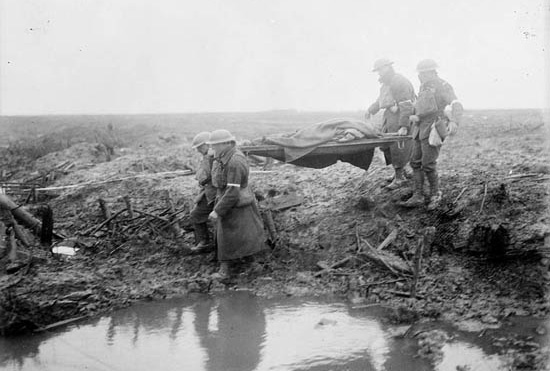Bloodshed and death
First World War Audio Archive
Bloodshed and death
Transcript
Medics carrying wounded soldier on stretcher.
Injured soldier stumbling around being guided by another soldier.
wounded. But on the second of September at the Drocourt-QueantSoldiers going through barbed wire and smoke.
Reference Map of the Hindenburg Line in relation to Vimy Ridge.
switch or the Hindenburg Line, whichever way you want to call it, they said that we’d never take the Hindenburg Line because it wasAerial photograph of the Hindenburg Line.
such a tremendous battlement, but when we got there, all it was was a bit of a ditch. And, of course, their gunners knew exactlySoldiers in the Hindenburg Line.
the range of that ditch, or that Hindenburg Line. And when we gotHorse and carriages.
into there, they just started to pour the ammunition, started to pour the shells in there and the casualties that, on the secondShells exploding behind soldiers as they attack.
of September, were terrific. Now out of a company machine gun,Artilllery guns firing.
Soldiers digging from the trenches.
out of a company, there are four machine gun crews in the companyPicture of machine gun crews in one company.
But after it was all over, the man that was in charge of that, Oscar Goldwyn, was the only lieutenant left. He came to me and he said, “How many, Spike,” he said, “how many machine gun crews can you arrange for? Can you get us one for the left flank and oneMachine gunner, loading his gun.
for the right?” And I said, “I think so.” “Okay.” So I figuredMachine gun crew in the trenches.
out who I was going to put in charge of each machine gun crew. And this one fellow that had been with me for all of time, a fellow by the name of Charlie Johnson, he said, “I want to be with you Spike.” I said, “Okay Charlie, I want you too,”Soldiers firing from the trenches.
and I put Punch Andrews over on the other side. And then I’veMachine gun firing rounds through belt.
forgotten who the detail was for each machine gun crew, but thereVaries different guns being fired.
would be about nine guys in each crew, on each gun, and all theSoldiers coming down a hill.
equipment that went with the machine gun crew. Well, I’d only gone a little piece with this fellow, Charlie Johnson, as I said before, when I got hit. But the casualties were terrific in that,Some of the casualties of the attack laying on stretchers.
as the same as it was at Vimy Ridge. When you go into a battle,Soldiers climbing the top of the trenches.
you go in there hoping that you’re going to come out, and if youHelmet on top of rifle, signifying dead soldier.
don’t come out, you’re going to stay there, one way or the other.Description
Mr. Smith describes the deadly impact of German defenses at Drocourt-Queant (Hindenburg Line).
Allan A ‘Spike’ Smith
Allan A ‘Spike’ Smith was born in Minto, Manitoba on May 7, 1894. Mr. Smith enlisted while attending the University of Saskatchewan, joining the 196th Battalion. He did his basic training at Camp Hughes, Manitoba. Once overseas, he was at Camp Seaford in England when he was selected to reinforce the 46th Battalion. He saw his first action just prior to Vimy, and was wounded by shrapnel at the Chalk Pits. He returned to action at Drocourt-Queant, and was again wounded by shrapnel. He later returned to Passchendaele. He received a Military Medal for bravery. After the war, Mr. Smith became a farmer, coached a women’s volleyball team, and became an agriculture inspector. He died on August 12, 1981.
Meta Data
- Medium:
- Video
- Owner:
- Veterans Affairs Canada
- Duration:
- 2:21
- Person Interviewed:
- Allan A ‘Spike’ Smith
- War, Conflict or Mission:
- First World War
- Location/Theatre:
- Europe
- Battle/Campaign:
- Drocourt-Queant
- Branch:
- Army
- Units/Ship:
- 196th Battalion
- Rank:
- Lance-Corporal
- Occupation:
- Infantryman
Attestation
Related Videos
- Date modified:




